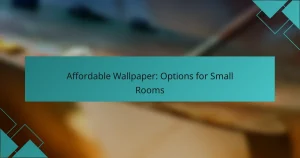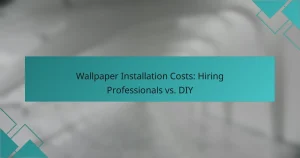Wallpaper can transform any space, offering a wide variety of styles and materials to suit your home’s aesthetic. From vinyl to eco-friendly options, understanding the unique characteristics of each type is essential for making the right choice. Additionally, considering factors like room size and lighting will help you select a design that enhances your decor. With various installation methods available, you can find an approach that fits your skill level and project needs.
Washable Wallpaper: Cleaning Techniques, Family Room Suitability
Washable wallpaper is an excellent choice for family rooms, combining durability with easy maintenance. Its ability to withstand regular cleaning ensures that it remains vibrant and free from stains, making…
Seasonal Wallpaper Maintenance: Tips for Seasonal Homes
Maintaining wallpaper in seasonal homes is essential for preserving its beauty and longevity. Regular cleaning, moisture control, and seasonal inspections are key practices that ensure your wallpaper remains inviting for…
Affordable Wallpaper: Options for Small Rooms
Transforming small rooms with affordable wallpaper can be both stylish and budget-friendly. By selecting the right colors, patterns, and textures, you can create an illusion of space and light, enhancing…
Geometric Wallpaper: Modern Aesthetics, Spatial Dynamics and Visual Interest
Geometric wallpaper serves as a powerful tool in modern interior design, infusing spaces with depth, character, and a contemporary aesthetic. By employing patterns that create visual intrigue, these wallpapers can…
Wallpaper Adhesives: Types, Brands and Performance Comparison
Choosing the right wallpaper adhesive is crucial for a successful installation, as it varies based on wallpaper type and application method. Popular options include paste-the-wall adhesives for their convenience and…
Vintage Wallpaper: Style Integration, Nostalgic Appeal and Modern Adaptation
Vintage wallpaper serves as a captivating bridge between the past and present, allowing homeowners to infuse their spaces with historical charm while embracing modern aesthetics. By thoughtfully integrating these nostalgic…
Wallpaper Removal: Techniques for Preserving Walls
Removing wallpaper can be a challenging task, but with the right techniques, you can preserve your walls in the process. Methods such as steam removal, wet techniques with vinegar, and…
Wallpaper Maintenance: Sunlight Impact, Best Practices
Sunlight plays a crucial role in wallpaper maintenance, as it can lead to fading, discoloration, and degradation of materials. By understanding these effects, you can select the right wallpaper and…
Wallpaper Selection: Room Lighting, Color Impact and Texture
When selecting wallpaper, it’s vital to consider the interplay of room lighting, color, and texture. Lighting can dramatically alter the appearance of colors and textures, influencing the overall ambiance of…
Bedroom Wallpaper: Cozy Designs, Space Optimization and Color Choices
Bedroom wallpaper plays a crucial role in enhancing the overall ambiance of your space, adding texture and warmth that fosters a cozy environment. By selecting the right designs and colors,…
What are the best wallpaper options for homes?
The best wallpaper options for homes include vinyl, fabric, peel and stick, textured, and eco-friendly varieties. Each type has unique characteristics that cater to different aesthetic preferences, durability needs, and installation methods.
Vinyl wallpaper
Vinyl wallpaper is popular for its durability and ease of cleaning. It is made from a synthetic material that can withstand moisture, making it ideal for kitchens and bathrooms.
When choosing vinyl wallpaper, consider the finish; options range from smooth to embossed textures. Look for washable varieties if you need to maintain cleanliness, especially in high-traffic areas.
Fabric wallpaper
Fabric wallpaper offers a luxurious look and feel, often made from natural fibers like cotton or silk. It provides excellent insulation and can enhance the acoustics of a room.
However, fabric wallpaper may require more maintenance and is less resistant to moisture. It is best suited for low-humidity areas, such as living rooms and bedrooms.
Peel and stick wallpaper
Peel and stick wallpaper is an easy-to-install option that adheres directly to the wall without the need for paste. This type is perfect for renters or those who frequently change their decor.
When selecting peel and stick wallpaper, ensure it is repositionable for easier application. It can be removed cleanly, making it a great choice for temporary designs.
Textured wallpaper
Textured wallpaper adds depth and dimension to walls, creating visual interest. It can come in various materials, including vinyl and fabric, and often features patterns like grasscloth or raised designs.
Consider the room's lighting when choosing textured wallpaper, as it can affect how the texture appears. Textured options are often more challenging to clean, so they are best used in areas with less foot traffic.
Eco-friendly wallpaper
Eco-friendly wallpaper is made from sustainable materials and non-toxic inks, making it a great choice for environmentally conscious homeowners. Options include wallpapers made from recycled paper or natural fibers.
When selecting eco-friendly wallpaper, look for certifications like FSC (Forest Stewardship Council) or Greenguard to ensure low emissions and sustainability. This type of wallpaper can be both stylish and responsible, fitting well in any room.
How to choose the right wallpaper for a room?
Choosing the right wallpaper for a room involves considering the space's size, lighting, and overall decor style. It’s essential to select a design that complements the room's purpose and enhances its aesthetic appeal.
Consider room size and lighting
The size of the room significantly impacts wallpaper choice. In smaller spaces, lighter colors and subtle patterns can create an illusion of openness, while darker shades may make a room feel cozier but can also appear cramped.
Lighting plays a crucial role as well. Rooms with ample natural light can handle bolder colors and intricate designs, whereas dimly lit areas benefit from lighter, reflective wallpapers that brighten the space.
Match wallpaper with decor style
Aligning wallpaper with the room's decor style is vital for a cohesive look. For instance, traditional spaces may suit floral or damask patterns, while modern interiors often favor geometric designs or solid colors.
Consider the existing furniture and accessories. A wallpaper that contrasts or complements these elements can enhance the overall design. For example, a minimalist room might benefit from a textured wallpaper to add depth without overwhelming the space.
Evaluate durability and maintenance
Durability is an essential factor, especially in high-traffic areas like hallways or children's rooms. Look for wallpapers that are washable or scrubbable to withstand wear and tear.
Maintenance requirements vary by material. Vinyl wallpapers are often more durable and easier to clean compared to paper options. When selecting wallpaper, consider how often you’ll need to clean or replace it, as this can impact long-term costs.
What are the installation methods for wallpaper?
There are several installation methods for wallpaper, each with its own advantages and considerations. The most common methods include paste-the-wall, traditional paste, and self-adhesive installation, which cater to different skill levels and project requirements.
Paste-the-wall method
The paste-the-wall method involves applying adhesive directly to the wall instead of the wallpaper. This technique allows for easier adjustments during installation, as the wallpaper can be repositioned before it fully adheres.
To use this method, first prepare the wall by ensuring it is clean and smooth. Apply the paste evenly across the wall, then hang the wallpaper strips from the top down. This method is particularly useful for beginners and can save time.
Traditional paste method
The traditional paste method requires applying wallpaper paste to the back of the wallpaper before hanging it. This method can provide a more secure bond but may be more challenging for inexperienced DIYers.
To execute this method, first mix the paste according to the manufacturer's instructions. Apply it evenly to the wallpaper, allowing it to soak for a few minutes before hanging. Be cautious of over-saturating the paper, as this can lead to tearing or wrinkling.
Self-adhesive installation
Self-adhesive wallpaper comes with a sticky backing, making it easy to install without additional paste. This method is ideal for renters or those looking for a quick and mess-free solution.
To install self-adhesive wallpaper, simply peel off the backing and press it onto the wall, smoothing out any air bubbles as you go. While this method is convenient, it may not adhere as well in humid environments, so consider the room's conditions before choosing this option.
What are the costs associated with wallpaper?
The costs associated with wallpaper include material, installation, and maintenance expenses. Understanding these costs can help you budget effectively for your wallpaper project.
Material costs
Material costs for wallpaper can vary widely based on the type and quality you choose. Basic vinyl wallpaper may range from $10 to $30 per roll, while designer or specialty papers can go from $50 to over $200 per roll.
When calculating material costs, consider the size of the area you plan to cover. Most rolls cover about 30 square feet, so you may need multiple rolls for larger rooms. Always factor in a little extra for mistakes or pattern matching.
Installation costs
Installation costs for wallpaper typically range from $0.50 to $2.50 per square foot, depending on the complexity of the job and the installer’s experience. Hiring a professional can ensure a seamless finish, especially with intricate patterns.
DIY installation can save money, but it requires time and skill. If you choose to install it yourself, invest in the right tools and take your time to avoid costly mistakes.
Maintenance costs
Maintenance costs for wallpaper include cleaning and potential repairs. Most wallpapers can be wiped down with a damp cloth, but some materials may require special cleaners, which can add to your expenses.
Consider the durability of the wallpaper you select; some types may need replacement sooner than others. Regular inspections can help you catch any peeling or damage early, saving you from more extensive repairs later.
What are the latest wallpaper trends in 2023?
The latest wallpaper trends in 2023 emphasize bold patterns, nature-inspired designs, and innovative textures. These styles cater to a growing desire for personalization and connection with the environment in interior spaces.
Bold patterns and colors
Bold patterns and vibrant colors are making a significant impact in 2023, allowing homeowners to express their individuality. Geometric shapes, oversized florals, and abstract designs are popular choices that can transform a room's atmosphere.
When selecting bold wallpapers, consider the overall color scheme of your space. Pairing a striking wallpaper with neutral furnishings can create a balanced look. Avoid overwhelming a small room with too many bold elements; instead, use them as an accent wall to draw attention without cluttering the space.
Nature-inspired designs
Nature-inspired designs are trending as people seek to bring the outdoors inside. Wallpapers featuring botanical prints, landscapes, and organic textures create a calming environment that promotes relaxation.
Choose wallpapers that reflect local flora or landscapes to enhance the connection to your surroundings. For example, tropical leaves can evoke a sense of vacation, while muted earth tones can create a serene atmosphere. Ensure the design complements your existing decor to maintain a cohesive look.
3D and textured wallpapers
3D and textured wallpapers add depth and dimension to walls, making them a popular choice in modern interiors. These wallpapers can mimic materials like wood, stone, or fabric, providing a tactile experience that enhances visual interest.
When opting for textured wallpapers, consider the lighting in the room, as it can dramatically affect how textures are perceived. Use these wallpapers in well-lit areas to highlight their unique features. Be cautious with maintenance; textured surfaces may require more cleaning than flat wallpapers, so choose materials that are easy to care for.






